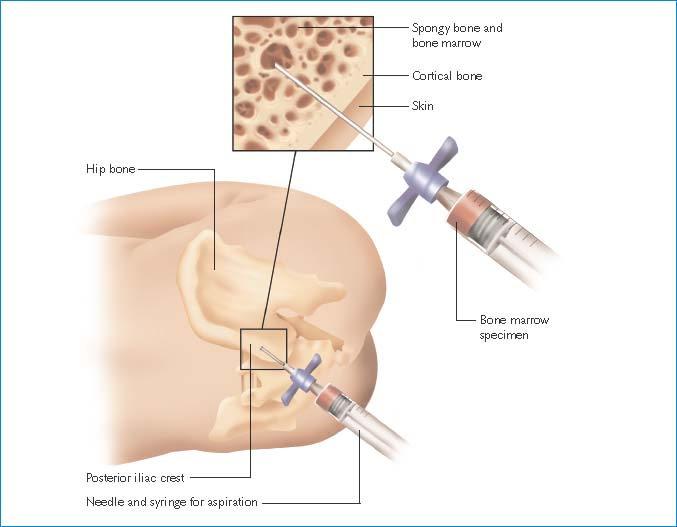Bone Marrow Aspiration and Biopsy
Bone marrow is the major site of blood cell formation. A bone marrow specimen may be obtained by aspiration or needle biopsy. Obtaining a specimen allows for evaluation of overall blood composition, blood elements, precursor cells, and abnormal or malignant cells. (See Obtaining a bone marrow specimen, page 86.)
Aspiration helps diagnose various disorders and cancers, such as oat cell carcinoma and leukemia as well as such lymphomas as Hodgkin’s disease. Cells are removed through a needle inserted into the marrow cavity of the bone. A biopsy removes a small, solid core of marrow tissue through the needle.
Both procedures are usually performed by a doctor, but some facilities authorize specially trained chemotherapy nurses or nurse clinicians to perform them with an assistant. The procedures are usually performed at the same time to stage the disease and monitor the patient’s response to treatment. Note, however, that bone marrow biopsy is contraindicated in patients with severe bleeding disorders.
Equipment
For Aspiration
Sterile gloves, masks, gowns, and goggles for the doctor and assistant ▪ antiseptic solution pads ▪ two sterile fenestrated drapes ▪ ten 4″ × 4″ gauze pads ▪ ten 2″ × 2″ gauze pads ▪ two 10-mL syringes ▪ 22G 1″ or 2″ needle ▪ scalpel ▪ sedative, as ordered ▪ specimen containers ▪ bone marrow needle ▪ 70% isopropyl alcohol ▪ 1% lidocaine (unopened bottle) ▪ 26G or 27G ½″ to 5/8″ needle ▪ adhesive tape ▪ glass slides and cover glass ▪ labels ▪ sterile marker ▪ sterile labels.
Most of the equipment above is available in a sterile, prepackaged tray. Familiarize yourself with your facility’s tray and obtain any additional equipment needed.
For Biopsy
All equipment listed above ▪ Vim-Silverman, Jamshidi, Illinois sternal, or Westerman-Jensen needle ▪ Zenker’s fixative.
Implementation
Gather the appropriate equipment.
Confirm the patient’s identity using at least two patient identifiers according to your facility’s policy.4
Tell the patient that the doctor will collect a bone marrow specimen, and explain the procedure to ease his anxiety and ensure cooperation. Tell him which bone will be aspirated. Inform him that he’ll receive a local anesthetic and feel heavy pressure from insertion of the biopsy or aspiration needle, as well as a brief pulling sensation. Tell him the doctor may make a small incision to avoid tearing the skin.
If the patient has osteoporosis, tell him that the needle pressure may be minimal; if he has osteopetrosis, inform him that a drill may be needed.
Make sure the patient or a responsible family member understands the procedure and signs a consent form obtained by the doctor.5
Inform the patient that the procedure normally takes about 20 minutes and that more than one marrow specimen may be required.
Check the patient’s history for hypersensitivity to the local anesthetic.
Conduct a preprocedure verification process to make sure that all relevant documentation, information, and equipment are available and correctly identified to the patient’s identifiers.6,7,8
Provide a sedative, as ordered, following safe medication administration practices.
Label all medications, medication containers, and other solutions on and off the sterile field.9
Verify that the doctor has marked the aspiration site with his initials or another unambiguous mark as determined by your facility’s policy. Confirm that the correct procedure has been identified for the correct patient at the correct site.6,7,8
Stay updated, free articles. Join our Telegram channel

Full access? Get Clinical Tree


Get Clinical Tree app for offline access

